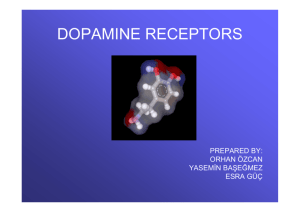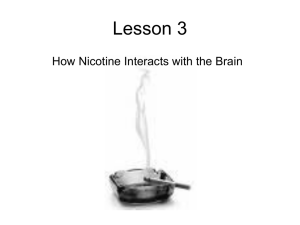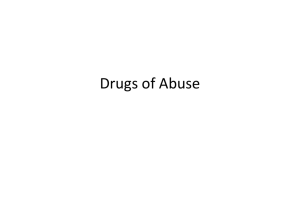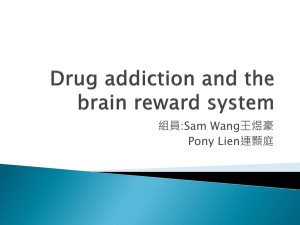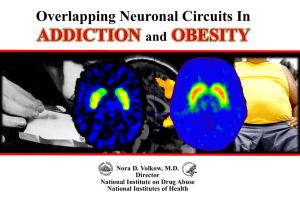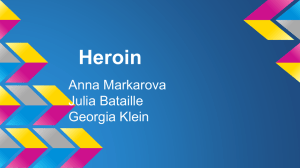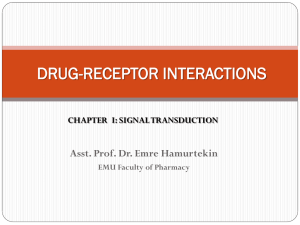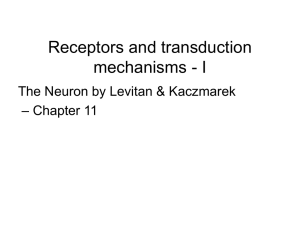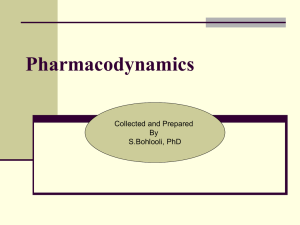Drug Abuse or… For Big Kids - Department of Cognitive Science
advertisement
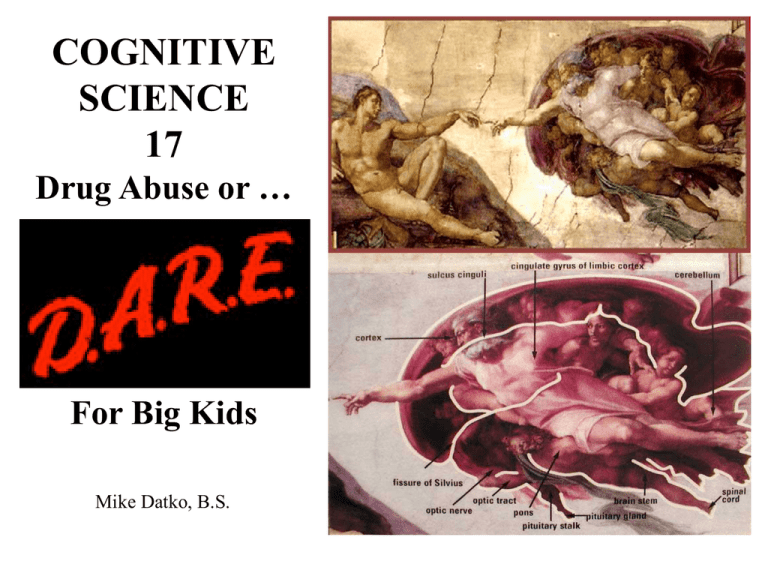
COGNITIVE SCIENCE 17 Drug Abuse or … Drug Abuse or… For Big Kids Mike Datko, B.S. Features of drug abuse and addiction • Definition: how are abuse and addiction defined clinically? • Positive reinforcement • Negative reinforcement • Opponent process theory • Craving and relapse Clinical definitions • Drug abuse is defined by the Diagnostic and Statistical Manual of Mental Disorders – A. A maladaptive pattern of substance use leading to clinically significant impairment or distress, as manifested by one (or more) of the following, occurring within a 12-month period: – 1. Recurrent substance use resulting in a failure to fulfill major role obligations at work, school, or home (e.g., repeated absences or poor work performance related to substance use; substance-related absences, suspensions or expulsions from school; neglect of children or household) – 2. Recurrent substance use in situations in which it is physically hazardous (e.g., driving an automobile or operating a machine when impaired by substance use) – 3. Recurrent substance-related legal problems (e.g., arrests for substance-related disorderly conduct) – 4. Continued substance use despite having persistent or recurrent social or interpersonal problems caused or exacerbated by the effects of the substance (e.g., arguments with spouse about consequences of intoxication, physical fights) – B. The symptoms have never met the criteria for Substance Dependence for this class of substance. A state of drug dependence is defined similarly, with the additional requirement of the manifestation of physical withdrawal symptoms when drug use is stopped. Koob (at UCSD) described addiction as involving “a cycle of spiraling dysregulation of brain reward systems that progressively increases, resulting in the compulsive use and loss of control over drug taking.” Positive reinforcement • An increase in the future frequency of a behavior due to the addition of a stimulus immediately following a response. (from Wikipedia) • If a person has a positive experience as a result of taking a drug, and subsequently takes more of the drug in the future, it is called positive reinforcement. Negative Reinforcement – Relief from withdrawal symptoms – If no withdrawal symptoms are present, relief from stress caused by emotional or life circumstances (or more generally, compensating for or reversing some physiological) – Example: Someone who drinks alcohol or takes other anxiolytic (anxiety-relieving) drugs to relieve naturally occurring anxiety is experiencing negative reinforcement. Opponent-process theory • Initially, positive effects of a drug easily outweigh negative effects. • Net effect of taking a drug is very positive. • As usage continues, homeostatic mechanisms become better at counteracting the acute effects of the drug. • Net effect is still positive, but less and less so. • At this point, positive effects of drug are equal to body’s homeostatic response. • In late stages of addiction, homeostatic “set point” has changed (a phenomenon called allostasis). • Net effect is neutral (must have drug to feel normal). • Net effect of drug use is negative, and the user must have the drug in order to prevent very negative feelings. Diagrams from Neurotopia.com • Addictive potential of a drug is related to its chemical properties as well as it’s route of administration. • Route of administration affects how quickly drug enters bloodstream. - Some routes, from fastest to slowest: • Intravenous injection, smoking, nasal insufflation, drinking/eating • Chemical properties of drug affect how easily/quickly it crosses the Blood Brain Barrier once its in the bloodstream. Amphetamine Methamphetamine Craving and Relapse • Incentive salience – Stimuli associated with drug taking become exciting and motivating – they become a provocation to act (from your book, pg. 618). – Craving is triggered in people with a history of drug abuse after exposure to drug-related stimuli (pictures, paraphernalia, smells, locations, people) • Brain areas involved in craving: – Medial Prefrontal Cortex and Nucleus Accumbens – In users, these areas show greater responses to drug-related cues than in non-users, but are less active at rest in users than in non users. Common Drugs of Abuse and their Effects • Opiates • Stimulants – Cocaine – Methamphetamine • Nicotine • Alcohol • Cannabis http://learn.genetics.utah.edu/content/addiction/drugs/mouse.html Opiates • Primarily heroin and oxycodone (most addictive) – Also, morphine, hydrocodone (Vicodin), methylmorphine (codeine) • Acute positive effects: euphoria, relaxation, analgesia (pain relief) • Acute negative effects: constipation, depressed breathing and heart rate (overdose can result in death because of this). • Opiates – site/mechanism of action: – Mu and delta opiate receptor agonist. • Mimics the effects of the body’s naturally occurring endorphins (but much stronger effect because concentrations are usually higher than those of endorphins) • Activation of opiate receptor inhibits release of GABA from an interneuron – Inhibits the inhibition (from GABA) on a neighboring neuron, which then releases more dopamine than usual to a post-synaptic neuron. (detailed diagram on next slide). – Studies with KO mice that lack mu-opiate receptor • KO mice do not develop conditioned place-preference or certain withdrawal symptoms. Stimulants: Cocaine and Methamphetamine • Sites of action: – Cocaine: inhibits dopamine reuptake in the synapse – dopamine sits in synapse for longer time and at higher concentrations. – Methamphetamine (and regular amphetamine): Causes vesicles containing dopamine to rupture within the presynaptic neuron and reverses the action of dopamine reuptake channels. Stimulants – effects of abuse • Figure 18.10 in book (pg 627) – after 25 days, close to 100% fatality rate in rats allowed to freely administer cocaine (vs 40% fatality rate for heroin). • Chronic users often develop hallucinations, delusions of persecution, mood disturbances, and repetitive behaviors which strikingly resemble symptoms of schizophrenia (role of dopamine system?). • Figure 18.12 (pg 628) – significantly lower concentrations of dopamine transporters, as measure with PET, in meth abusers compared to controls. – one issue with this type of study is the ambiguity of the cause of reduced dopamine transporters/dopaminergic terminals – did meth abuse cause this difference or was it the result of previously existing factors such as genetics (in which case, did these genetic differences predispose the individual to drug abuse?)? • • Figure 18.14 (pg 629) – significantly lower dopamine receptors in striatum of meth abusers. Damaged dopamine system = higher risk of developing Parkinson’s Disease as age increases? Nicotine • Mechanism of action: – Agonist at nicotinic acetylcholine receptors. – Ionotropic receptor (rapid effects of activation) – Most nicotinic receptors are heteroreceptors on postsynaptic neurons (their activation causes the release of other neurotransmitters into the synaptic cleft). • Nicotine is responsible for addiction and craving associated with cigarettes, but is not the major cause of health problems. – Other ingredients and carcinogens found in smoke lead to cancer and cardiovascular problems. – Nicotine alone is only toxic in high doses Alcohol • Mechanism/site of action: – Indirect agonist at GABA-A receptors and indirect antagonist at NMDA receptors. • Produces both positive and negative reinforcement: – Mild euphoria, rise in dopamine in NAC: positive reinforcement – Reduction of anxiety (GABA actions): negative reinforcement • Unlike with most drugs, severe withdrawal symptoms from alcohol can be fatal. – Convulsions and seizures result from a hypersensitization of NMDA receptors that occurs with long-term alcohol use. • Long-term use leads to lower amounts of dopamine receptors in the striatum. • Korsakoff’s syndrome – anterograde and retrograde amnesia, apathy, and other symptoms – Result of thiamine deficiency that often occurs as a result of alcoholism Cannabis • Main psychoactive compound is Tetrahydrocannabinol (THC) • Mechanism/site of action – agonist at CB1 receptors. – CB1 receptors are normally sensitive to endogenous cannabanoids like anandamide. – Like other drugs of abuse, use leads to temporary increase in dopaminergic activity in key areas – Hippocampus contains a large concentration of CB1 receptors • May explain effect of cannabis on memory formation • One of the few drugs of abuse that has extremely low overdose potential. – Very low concentrations of CB1 receptors in brain stem Treatments and Therapies • Opiates – – Methadone: mu-opiate receptor agonist • Has effects similar to heroin but administered in a controlled setting (clinic, by nurses/doctors) and taken in liquid form. – Buprenorphine: mu-opiate partial agonist • Competes at same receptor as normal opiates but produces much less of an effect when it binds. Treatments: stimulants • Immunotherapy: – Create and administer proteins that make the immune system attack a given drug. • For example, giving someone a dose of proteins that resemble cocaine but are not actually cocaine will train their immune system to eliminate actual cocaine as if it were a disease-inducing virus. • Gamma-vinyl GABA (GVG) – GABA receptor agonist that reduces the reinforcing effects of cocaine. Treatments: Nicotine • Nicotine gum and patch: – Maintains a constant level of nicotine to avoid withdrawal symptoms, but does not produce a “nicotine buzz” because it takes much longer to enter the bloodstream than smoked nicotine. • Bupropion (Wellbutrin, Zyban) – Catecholamine reuptake inhibitor that reduces cravings. Treatments: Alcohol • Ro15-4513 prevents intoxication by blocking alcohol binding site on GABA-A receptor. – NOT used because it would enable people to potentially drink toxic amounts of alcohol without feeling any noticeable effects. • Naltrexone – opiate receptor antagonist – Alcohol induces the release of endogenous opioids (endorphins). – Davidson, Swift, and Fitz (1996) study with social drinkers – found that subjects who were taking naltrexone prior to a drinking session drank slower and drank less than controls. • Acamprosate – NMDA receptor antagonist – Eases withdrawal symptoms and makes alcoholics less likely to drink again after treatment. Other facts/info • The majority of people who try addictive drugs do not become addicted. • Heredity (genetics) seems to dictate who becomes addicted after trying a drug, but environment (friends, family, etc.) is a more important factor in determining whether or not someone will try a drug initially.
